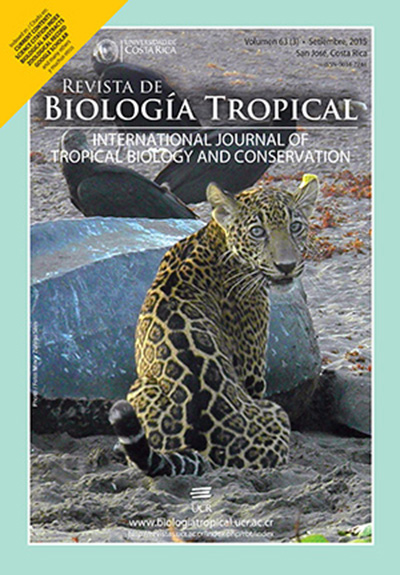Abstract
Seasonally dry tropical forests are considered as the most endangered ecosystem in lowland tropics. The aim of this study was to characterize the floristic composition, richness, diversity, structure and regeneration of a seasonally dry tropical forest landscape constituted by mature forest, secondary forest and seasonally inundated forest located in the Northeastern part of the Yucatán Península, Mexico. We used the Gentry’s standard inventory plot methodology (0.1 ha per forest type in 2007) for facilitating comparison with other Mesoamerican seasonally dry tropical forests; a total of 10 plots were sampled. A total of 77 species belonging to 32 families were observed in the study area. Fabaceae and Euphorbiaceae were the families with the largest taxonomic richness in the three forest types. Low levels of b diversity were observed among forest types (0.19-0.40), suggesting a high turnover of species at landscape level. The non-regenerative species were dominant (50-51 %), followed by regenerative species (30-28 %), and colonizer species (14-21 %) in the three forest types. Zoochory was the most common dispersal type in the study area. The 88 % of the observed species in the study area were distributed in Central America. Some floristic attributes of the seasonally dry tropical forest of the Yucatán Península, fall into the values reported for Mesoamerican seasonally dry tropical forests. Natural disturbances contributed to explain the high number of individuals, the low number of liana species, as well as the low values of basal area observed in this study. Our results suggested that the seasonally dry tropical forest of Yucatán Península seems to be resilient to natural disturbances (hurricane) in terms of the observed number of species and families, when compared with the reported values in Mesoamerican seasonally dry tropical forests. Nonetheless, the recovery and regeneration of vegetation in long-term depends on animal-dispersed species. This study highlights the importance of establishing multiple protected areas throughout the Mesoamerican seasonally dry tropical forest in order to conserve both µ- and b- diversity.
References
Chazdon, R. L., Finegan, B., Capers, R. S., Salgado-Negret, B., Casanoves, F., Boukili V., & Norden, N. (2010). Composition and Dynamics of Functional Group of Trees During Tropical Forest Succession in Northeastern Costa Rica. Biotropica, 42(1), 31-40.
Dezzeo, N., Flores, S., Zambrano-Martínez, S., Rodgers L., & Ochoa, E. (2008). Estructura y composición florística de Bosques secos y sabanas en los llanos orientales del Orinoco, Venezuela. Interciencia, 33(10), 733-740.
Foster, D. R. (1988). Disturbance history, Community Organization and Vegetation Dynamics of the Old-Growth Pisgah Forest, South-Western New Hampshire, USA. Journal of Ecology, 76(1), 105-134.
Gentry, A. H. (1982). Patterns of neotropical plant species diversity. Evolutionary Biology,15, 1-84.
Gillespie, T. W. (1999). Life history characteristics and rarity of woody plants in tropical dry forest fragments of Central America. Journal of Tropical Ecology, 15, 637-649.
Gillespie, T. W., Grijalva, A., & Farris, C. N. (2000). Diversity, composition, and structure of tropical dry forests in Central America. Plant Ecology, 147, 37-47.
Hernández-Ramírez, A. M. (2012). Distyly, Floral Visitors, and Fructification in 2 Natural Populations of Psychotria nervosa (Rubiaceae). Ecoscience, 19(2), 133-139.
Lott, E. J., Bullock, S. H., & Solis-Magallanes, J. A. (1987). Floristic Diversity and Structure of Upland and Arroyo Forests of Coastal Jalisco. Biotropica, 19(3), 228-235.
Magurran, A. E. (1998). Ecological Diversity and its Measurement. Princeton, N.J.: Princeton University Press.
Pennington, R. T., Lavin, M., & Oliveira-Filho, A. (2009). Woody Plant Diversity, Evolution, and Ecology in the Tropics: Perspectives from Seasonally Dry Tropical Forests. Annual Review of Ecology and Systematics, 40, 437-457.
Pineda-García, F., Arredondo-Amezcua, L., & Ibarra-Manríquez, G. (2007). Riqueza y diversidad de especies leñosas del bosque tropical caducifolio El Tarimo, Cuenca del Balsas, Guerrero. Revista Mexicana de Biodiversidad, 78, 129-139.
Powers, J. S., Becknell, J. M., Irving, J., & Pèrez-Aviles, D. (2008). Diversity and structure of regenerating dry tropical forest in Costa Rica: Geographic patterns and environmental drivers. Forest Ecology and Management, 258, 959-970. doi:10.1016/j.foreco.2008.10.036
R Development Core Team (2009). R: A Language and Environment for Statistical Computing R. Foundation for Statistical Computing, Vienna.
Ruiz, J., & Fandiño, M. C. (2010). The impact of hurricane Beta on the forest of Providencia island, Colombia, southwest Caribbean. Caldasia, 32(2), 425-434.
Standley, P. C., Williams, L. O., & Gibson, D. N. (eds.) (1946-1969). Floral de Guatemala. USA: Chicago Natural History Museum Press.
Trejo, I., & Dirzo, R. (2002). Floristic diversity of Mexican seasonally dry tropical forests. Biodiversity and Conservation, 11, 2063-2048.
Villarroel, D., Pinto, J. N., Centurión, T. R., & Parada, A. (2009). Relación de la cobertura leñosa con la riqueza herbácea en tres fisionomías del Cerrado censu lato (Cerro Mutún, Santa Cruz, Bolivia). Ecología en Bolivia, 44(2), 83-98.
Xi, W., Peet, R. K., & Urban, D. L. (2008). Changes in forest structure, species Diversity and spatial pattern following hurricane disturbance in a Piedmont North Carolina forest, USA. Journal of Plant Ecology, 1(1), 43-57.
##plugins.facebook.comentarios##

This work is licensed under a Creative Commons Attribution 4.0 International License.
Copyright (c) 2015 Revista de Biología Tropical






